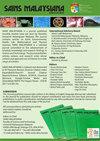工业锡尾矿处理废水中天然放射性核素和重金属污染的辐射影响评价
IF 0.8
4区 综合性期刊
Q3 MULTIDISCIPLINARY SCIENCES
引用次数: 0
摘要
本研究调查马来西亚锡尾处理厂废水的放射性危害及重金属污染。样本是从分散在马来西亚霹雳州的七个独立锡尾矿加工厂的保留池中收集的。样品分别用伽玛射线能谱系统和电感耦合等离子体质谱分析放射性和重金属浓度。分析表明,样品中镭-226 (226Ra)、镭-228 (228Ra)和钾-40 (40K)的浓度分别为2.4 ~ 34.9 Bq/l、0.8 ~ 14.7 Bq/l和19.5 ~ 299.4 Bq/l。这些水平超过了监管机构设定的控制限值(226Ra和228Ra分别为5 Bq/l和10 Bq/l)。重金属污染分析表明,砷(As)和铅(Pb)浓度分别高于最大浓度水平(MCL) 0.01和0.015 mg/L。进一步的辐射影响评价表明,水摄入的平均年有效剂量(AED)和外部照射的平均年有效剂量(AED)分别为1.43±0.67 mSv/y和1.71±0.79 mSv/y。而对于非致癌性和致癌性风险评估,危害指数和终生癌症风险分别为2.1×10-10和1.2×10-7。这些研究结果表明,在排放到排水系统之前,应对废水进行有效处理,以防止放射性核素和重金属在环境中积累,从而可能对公众健康构成威胁。本文章由计算机程序翻译,如有差异,请以英文原文为准。
Radiological Impact Assessment of Natural Radionuclides and Heavy Metal Contamination in Industrial Tin-Tailing Processing Effluent
This study investigates the radiological hazard and heavy metal contamination of water effluents from Malaysian tin-tailing processing plants. Samples were collected from retention ponds in seven separate tin tailing processing plants scattered throughout the state of Perak, Malaysia. Samples were analysed for radioactivity and heavy metal concentration using Gamma-ray Spectrometry System and Inductively Coupled Plasma-Mass Spectrometry, respectively. The analysis indicates that the concentration of Radium-226 (226Ra), Radium-228 (228Ra), and Potassium-40 (40K) in samples ranged from 2.4 - 34.9 Bq/l, 0.8 - 14.7 Bq/l, and 19.5 - 299.4 Bq/l, respectively. These levels surpassed the control limits (5 Bq/l and 10 Bq/l for 226Ra and 228Ra) set by the regulatory authority. The analysis of the heavy metal contamination showed that the concentration of Arsenic (As) and Lead (Pb) werehigher than the Maximum Concentration Level (MCL) of 0.01 and 0.015 mg/L, respectively. Further evaluation of radiological impact showed that the average Annual Effective Doses (AED) by water ingestion and AED for external exposure are 1.43±0.67 mSv/y and 1.71±0.79 mSv/y, respectively. While for non-carcinogenic and carcinogenic risk assessments, the value of hazard index and lifetime cancer risk is 2.1×10-10 and 1.2×10-7, respectively. These research findings suggest that effective treatment of the effluent should be implemented before discharge into the drainage system to prevent the accumulation of radionuclides and heavy metals in the environment, which may pose a risk to public health.
求助全文
通过发布文献求助,成功后即可免费获取论文全文。
去求助
来源期刊

Sains Malaysiana
MULTIDISCIPLINARY SCIENCES-
CiteScore
1.60
自引率
12.50%
发文量
196
审稿时长
3-6 weeks
期刊介绍:
Sains Malaysiana is a refereed journal committed to the advancement of scholarly knowledge and research findings of the several branches of science and technology. It contains articles on Earth Sciences, Health Sciences, Life Sciences, Mathematical Sciences and Physical Sciences. The journal publishes articles, reviews, and research notes whose content and approach are of interest to a wide range of scholars. Sains Malaysiana is published by the UKM Press an its autonomous Editorial Board are drawn from the Faculty of Science and Technology, Universiti Kebangsaan Malaysia. In addition, distinguished scholars from local and foreign universities are appointed to serve as advisory board members and referees.
 求助内容:
求助内容: 应助结果提醒方式:
应助结果提醒方式:


